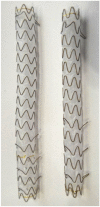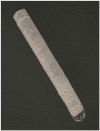Functional self-expandable metal stents in biliary obstruction
- PMID: 24143314
- PMCID: PMC3797937
- DOI: 10.5946/ce.2013.46.5.515
Functional self-expandable metal stents in biliary obstruction
Abstract
Biliary stents are widely used not only for palliative treatment of malignant biliary obstruction but also for benign biliary diseases. Each plastic stent or self-expandable metal stent (SEMS) has its own advantages, and a proper stent should be selected carefully for individual condition. To compensate and overcome several drawbacks of SEMS, functional self-expandable metal stent (FSEMS) has been developed with much progress so far. This article looks into the outcomes and defects of each stent type for benign biliary stricture and describes newly introduced FSEMSs according to their functional categories.
Keywords: Bile ducts, extrahepatic; Biliary tract; Drug-eluting stents; Stents.
Conflict of interest statement
The authors have no financial conflicts of interest.
Figures





References
-
- Baron TH. Covered self-expandable metal stents for benign biliary tract diseases. Curr Opin Gastroenterol. 2011;27:262–267. - PubMed
-
- Costamagna G, Pandolfi M, Mutignani M, Spada C, Perri V. Long-term results of endoscopic management of postoperative bile duct strictures with increasing numbers of stents. Gastrointest Endosc. 2001;54:162–168. - PubMed
-
- Costamagna G, Tringali A, Mutignani M, et al. Endotherapy of postoperative biliary strictures with multiple stents: results after more than 10 years of follow-up. Gastrointest Endosc. 2010;72:551–557. - PubMed
-
- Perri V, Familiari P, Tringali A, Boskoski I, Costamagna G. Plastic biliary stents for benign biliary diseases. Gastrointest Endosc Clin N Am. 2011;21:405–433. - PubMed
Publication types
LinkOut - more resources
Full Text Sources
Other Literature Sources

